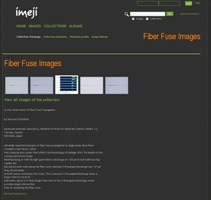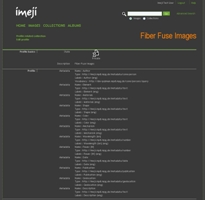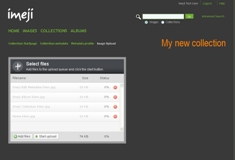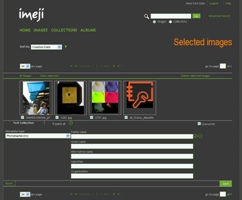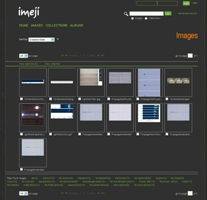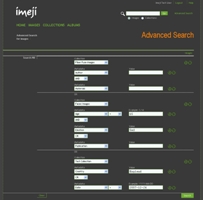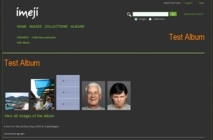Template:Imeji
This page gives a short overview of all imeji functionalities.
The detailed functional specifications can be found here.
Standard User Workflow
Upload content
- Creation of a collection with collection metadata
- Assignment of a metadata profile to the collection
- via using an already defined profile as template
- via creating a new profile
- Upload of pictures to the collection
- via selecting one or several single picture
- via selecting one folder
- Assignment of metadata to pictures
- Automatic extraction and assignment of technical metadata
- Defining of a picture set for batch editing of descriptive metadata via filtering and sorting mechanism
- Editing of the descriptive metadata of a single picture
- Releasing the whole collection (make it visible for all users)
|
|
|
|
- Definition
- A collection has exactly one metadata profile
- A collection has exactly one creator, but can have multiple editors (people who are allowed to assign metadata values and upload pictures) --> the creator automatically has the editor role for his collection
- A collection has one entry point
- Create/edit collection (edit the metadata values)
- Delete/release/discard collection
- Display of collections
- List of all published collections together with the most relevant metadata values
|
|
|
|
|
- Definition
- A metadata profile always belongs to a collection
- The user either can create a new metadata profile for a new collection or use an already available one as template.
- Edit metadata profile
- Each metadata consists of
- one type (a list with several types will be provided, e.g. date, geonames, string, integer, cone-person)
- one or several labels
- a language tag for each label
- a menu to select cardinality (unique, multiple)
- (optional) the possibility to define a small controlled vocabulary based on free text fields (strings)
- Version control will not be provided for the metadata profile
- Therefore a metadata profile will be unique for each collection, no possibility to use it for more than one collection
- metadata profiles do not have an own release work flow as they inherit the collections work flow
|
|
|
|
|
- Picture upload
- Web upload (upload images for one collection)
- Easy Drag&Drop, via selecting one or several pictures
- Create thumbnails and web resolution and upload all 3 resolutions
- Extract technical metadata (IIO (java) output)
- Technical metadata will be displayed only in xml (via link)
|
|
|
|
|
- Batch editing (only possible for pictures within the same collection)
- Select images
- Edit metadata values
- Choose metadata element
- Define a new value for all selected pictures and decide whether this value
- should only be added to the pictures when the value there is still empty
- should overwrite all already available values
- add a new value to all images (only possible when the selected metadata element can occur multiple times)
- Define a new value for each selected picture separately
- Single editing
|
|
|
|
|
- Browse collections (collection portal: overview about all available collections)
- View images within one collection
- Filter images through facets based on the corresponding metadata profile
- Browse albums
- Browse images
- Filter images through general facets
- Navigate through images (paginator with additionally 'go to' functionality)
- View picture details
|
|
|
|
|
- Simple search: general free text search (any metadata value, either in images or collections)
- Advanced Search
- For pictures (metadata values)
- Select a collection and then a metadata element within this collection
- Combine as many collections and metadata elements with boolean operators
|
Albums
|
|
|
|
- Creation and editing of private albums
- Adding pictures to an album via selecting an album as 'active' album when browsing through the pictures
- Remove pictures from an album
- Deletion of a private albums with all its content
- Publishing and discarding of an album
|
Further Features
